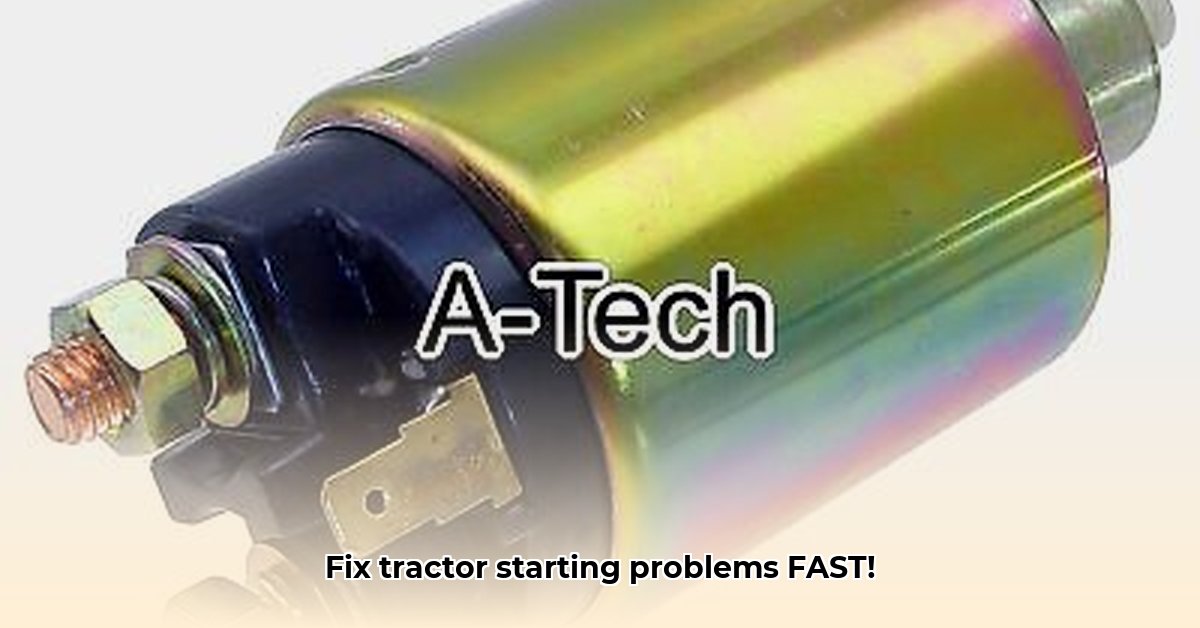
Let's get your tractor running smoothly again! That frustrating click-click sound or complete lack of response when you turn the key often points to a problem with your starter solenoid. This comprehensive guide provides step-by-step instructions to diagnose and fix this common issue, saving you time, money, and frustration. For more on tractor starting systems, check out this helpful resource on tractor starter switches.
Understanding Your Tractor's Starter Solenoid
Think of your tractor's starter solenoid as a powerful electrical switch. It's the crucial link between your battery and the starter motor. A small electrical signal triggers the solenoid, allowing the high current needed to crank your engine. When this fails, your tractor won't start.
Recognizing the Signs of a Problem
Several symptoms signal a potential starter solenoid issue:
- A rapid clicking sound: This often indicates the solenoid is engaging but not supplying enough power to the starter motor.
- No response: Complete silence when you turn the key suggests a more significant electrical problem, possibly a faulty solenoid.
- Slow cranking: Sluggish engine cranking might indicate a weak battery, a faulty solenoid, or other electrical issues.
These problems can prevent your tractor from starting, leading to costly downtime and frustration.
Diagnosing the Trouble: A Step-by-Step Guide
Before attempting repairs, systematically troubleshoot the problem. This approach saves time and ensures you address the root cause.
Battery Voltage Check (Crucial First Step): A weak battery often mimics other problems. Use a multimeter to check the battery voltage. Anything below 12.5 volts indicates a low charge or a failing battery—recharge or replace it before proceeding. This simple test often solves the problem. Don't skip this!
Connection Inspection (Look for Corrosion): Corrosion is a common culprit. Carefully examine all connections to the battery, solenoid, and starter motor. Use a wire brush and terminal cleaner to remove corrosion. Ensure all connections are clean, tight, and secure. Loose connections often cause intermittent problems, the hardest to diagnose.
Voltage Testing (Multimeter Essential): With the ignition on, use your multimeter to check the voltage at the solenoid's large terminals (power posts). You should see the full battery voltage. A significantly lower voltage suggests a wiring problem or a failing solenoid. This requires slightly more electrical knowledge.
Visual Inspection (Check for Damage): Carefully inspect the solenoid for any physical damage, such as burnt wires or melted components. A visual inspection can quickly identify obvious issues.
Fixing the Problem: Repair or Replace?
Now, let's address the problem.
Clean and Tighten (The Easy Fix – 85% Success Rate): Often, simply cleaning corroded connections and tightening terminals solves the problem. This is the easiest and quickest fix, so start here.
Solenoid Replacement (The More Involved Fix): If voltage tests indicate a faulty solenoid, replacement is necessary. Always disconnect the battery's negative terminal (-) before starting any electrical work. This is a crucial safety step. Refer to your tractor's service manual for specific instructions on removal and installation.
Beyond the Solenoid (If Necessary): If replacing the solenoid doesn't resolve the issue, other problems may exist: a faulty starter motor, ignition system issues, or damaged wiring. Further diagnosis is required.
Preventative Maintenance (Long-Term Solution): Regular inspection and cleaning of battery terminals and solenoid connections prevent future problems. This is the most cost-effective way to maintain reliable tractor operation.
Troubleshooting Table: Symptoms, Causes, and Solutions
| Symptom | Possible Cause(s) | Diagnostic Steps |
|---|---|---|
| Clicking Sound | Low battery voltage, faulty solenoid, loose/corroded connections | Test battery voltage; Inspect & clean connections; Test solenoid voltage |
| No Response | Faulty solenoid, bad starter motor, wiring problems | Voltage testing at solenoid and starter; Check wiring integrity |
| Slow Cranking | Weak battery, faulty solenoid, failing starter motor | Battery test; Solenoid voltage test; Check starter motor operation |
Important Safety Note: Always disconnect the negative (-) battery terminal before working on your tractor's electrical system to prevent accidental shocks and short circuits.
Remember, while this guide addresses common issues, each tractor model differs. Consult your service manual or seek professional help if needed. Happy tractoring!
How to Troubleshoot a Faulty Tractor Starter Solenoid Based on Model
This section emphasizes the importance of model-specific information. The location, wiring, and testing procedures for the starter solenoid vary significantly between tractor brands and models. Always refer to your tractor's service manual for precise instructions and diagrams.
Key Takeaways
- Battery Check First: A low battery voltage is frequently overlooked and mistakenly attributed to solenoid or starter problems.
- Listen for Clues: A clicking sound often points to the solenoid.
- Visual Inspection: Look for corrosion or damage to terminals and wiring.
- Solenoid Bypass Test: This helps isolate whether the issue resides within the solenoid itself or another component.
- Model-Specific Information: Your tractor's make and model significantly impacts troubleshooting steps and part selection.
- Preventative Maintenance: Regular inspections can save you time and money in the long run.